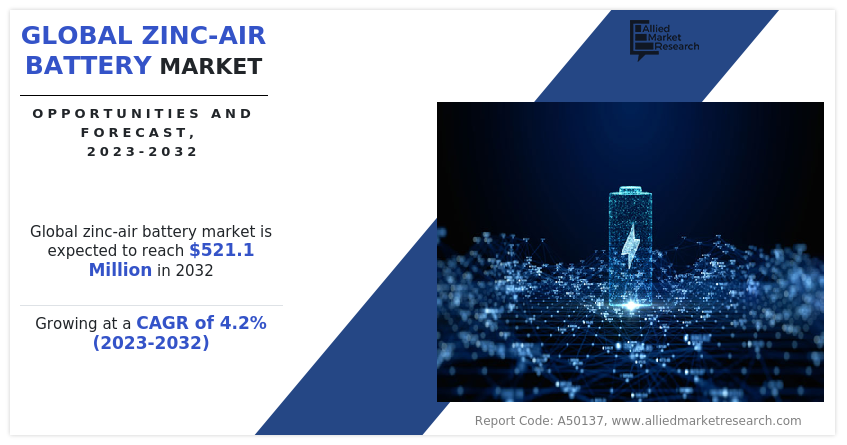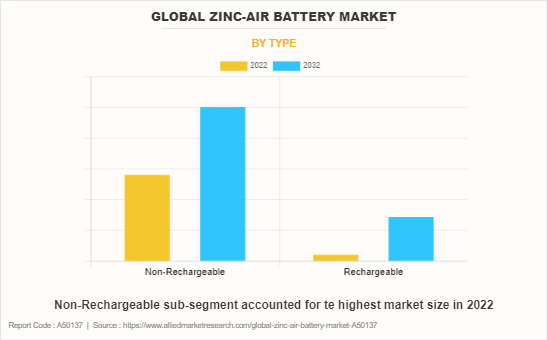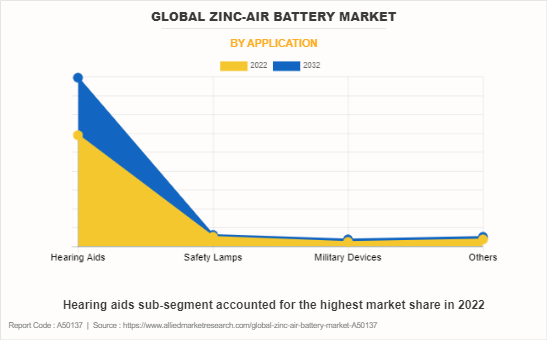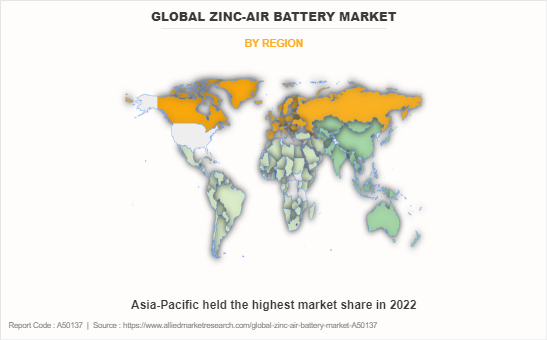Global Zinc-Air Battery Market Research, 2032
The global zinc-air battery market size was valued at $350.2 million in 2022, and is projected to reach $521.1 million by 2032, growing at a CAGR of 4.2% from 2023 to 2032. A zinc-air battery is a type of metal-air battery that generates electricity by oxidizing zinc and reducing oxygen. As this electrochemical process uses air oxygen as a reactant, the battery is naturally lightweight and efficient. A zinc anode, an air cathode, and an electrolyte are the three main components of a zinc-air battery. During discharge, zinc oxidizes at the anode, releasing electrons that proceed via an external circuit to the cathode, where oxygen reduction takes place. This flow of electrons provides electrical energy, which may be used for a variety of purposes. This process is reversed during the charging phase, allowing zinc to be electrochemically deposited back onto the anode.

Zinc-air batteries' robustness and longer life cycle contribute greatly to their appeal for a wide range of applications. The number of charge and discharge cycles a battery may go through while maintaining a given level of performance is referred to as its cycle life. When correctly built and manufactured, zinc-air batteries may have an outstanding cycle life, making them appropriate for applications requiring long-term durability. This property is especially useful in grid energy storage systems and renewable energy integration, where batteries may undergo numerous charge and discharge cycles. Continuous technical breakthroughs are being driven by ongoing R&D activities in the field of zinc-air batteries.
These advancements attempt to solve issues like energy efficiency, power density, and overall performance, hence increasing the appeal of zinc-air technology. Another significant benefit of zinc-air batteries is their high cycle life. Zinc-air batteries have a long operating lifespan due to their ability to withstand several charge and discharge cycles without substantial deterioration. This lifespan is especially beneficial in situations where maintenance and replacement costs are crucial, adding to the overall cost-effectiveness and dependability of zinc-air battery systems.
Power density is a major concern with zinc-air batteries. Despite their great energy density, these batteries have difficulty delivering power at rates like conventional battery technologies. Because of this constraint, they are less appropriate for applications requiring quick charging and discharging, such as electric cars or high-power electrical gadgets. The battery's practical value in certain circumstances is limited due to the relatively sluggish kinetics of the oxygen reduction and evolution events at the air electrode. The issue of electrolyte evaporation is another difficulty with zinc-air batteries. The electrolyte, which is essential for allowing electrochemical reactions within the battery, might evaporate with time, resulting in a reduction in performance and capacity. This evaporation is most noticeable in open-system zinc-air batteries, which take air from the surrounding environment.
Controlling and minimizing electrolyte evaporation is a technological difficulty that must be overcome to improve the long-term stability and dependability of zinc-air batteries. In addition, the susceptibility of zinc-air batteries to external conditions is a considerable disadvantage. Moisture and carbon dioxide in the air can interfere with electrochemical reactions and reduce performance of these batteries. Due to their sensitivity, they can only be used in limited settings and require careful sealing and encapsulation, which adds complexity and cost to the overall battery design.
Scientists and engineers are attempting to tackle some issues related with zinc-air batteries as part of continuing R&D activities. One such issue is the problem of limited rechargeability. While zinc-air batteries may be recharged to some extent, there are concerns regarding performance loss after numerous charge and discharge cycles. Addressing this constraint is critical for assuring zinc-air batteries' long-term viability and competition with alternative energy storage technologies. Collaborations between businesses, universities, and government agencies are critical to the advancement of zinc-air battery technology. It is critical to fund and support research activities aimed at enhancing the efficiency, durability, and scalability of zinc-air batteries to realize their full potential.
Governments and politicians may help by rewarding the development and deployment of zinc-air batteries through grants, subsidies, and regulatory frameworks that support the use of environmentally friendly energy alternatives. Zinc-air batteries, unlike certain lithium-ion batteries, are inherently more environmentally friendly since they do not rely on rare and toxic materials. Zinc is a readily available and recyclable substance that fits with the worldwide trend towards more ecologically friendly energy sources. This feature not only reduces the environmental impact of EVs, but it also aligns with both manufacturers' and consumers' sustainability goals.
The key players profiled in this report include Duracell, Electric Fuel Battery Corporation, ZAF Energy System, Ravoyac, Nantenergy, Varta AG, GP Batteries, Phinenergy, Renata SA, and Thunderzee. Acquisitions, mergers, and research and development (R&D) are common strategies followed by major market players. For instance, on January 12, 2021, Thunderzee invented a revolutionary Zinc air battery that not only eliminates the risk of fire that is commonly seen in lithium-ion batteries but also provides more energy, weighs less, costs less and is environmentally friendly. With 3 patents on file and more to follow, the Zinc air battery is ideal for a vast variety of consumer applications.
Segments Overview
The zinc-air battery market is segmented on the basis of type, application, and region. By type, the market is divided into non-rechargeable and rechargeable. By application, the market is classified into hearing aids, safety lamps, military devices, and others. By region, the market is analyzed across North America, Europe, Asia-Pacific, and LAMEA.

By type, the non-rechargeable sub-segment dominated the zinc air battery market share in 2022. Zinc-air batteries have a much longer shelf life than many other non-rechargeable options. They are able to remain inactive for longer periods of time due to their unique design, making them suitable for devices that may lie on shelves for extended periods of time, such as emergency equipment, remote sensors, or backup power systems. This increased longevity assures that the battery is ready to give power whenever it is required, avoiding concerns about deterioration over time.
Zinc-air batteries' flexibility makes them appropriate for a wide range of applications. These batteries find use in a wide range of sectors, from small-scale devices like hearing aids and remote sensors to bigger systems like backup power supply for vital infrastructure. Their ability to provide steady power for an extended time without the need for recharging makes them more appealing for applications requiring accessibility or maintenance. Because of its scalability, zinc-air battery technology is a possible choice for future developments in non-rechargeable energy storage. Researchers are continually looking for methods to improve performance, save costs, and broaden the variety of applications.

By application, the hearing aids sub-segment dominated the zinc air battery market opportunities in 2022. Zinc-air batteries are well-known for their high energy density and long lifespan when compared to other battery technologies. This is a significant benefit for hearing aid users since it decreases the frequency of battery replacements, improving convenience and cutting total maintenance expenses. Zinc-air batteries are stable throughout a wide temperature range, ensuring consistent performance in a variety of environmental situations. This capability is critical for hearing aid users who may be in a variety of climates or settings.
Zinc-air batteries, unlike certain older battery types, have little chance of leaking. This is especially beneficial for delicate electrical components found in hearing aids, where leaking can cause damage and affect operation. Zinc-air batteries' small form factor and high energy density complement the sleek and futuristic forms of current hearing aids. Because of this connectivity, manufacturers may design smaller, more discrete devices without sacrificing power or performance. Zinc-air batteries are often designed to be simple and user-friendly. The electrochemical reaction is initiated by removing a tab that exposes the zinc surface to air. This simplicity of use improves hearing aid accessibility, particularly for people with coordination concerns.

By region, Asia-Pacific dominated the zinc air battery market in 2022. Many Asia-Pacific countries are actively investigating methods to lessen their reliance on traditional energy sources, particularly fossil fuels. Zinc-air batteries represent a possible path towards energy independence, allowing governments to diversify their energy mix and improve energy security. Asia-Pacific is seeing an increase in energy consumption because of its growing population and rapid economic growth. Because of its scalability, zinc-air batteries may be implemented at various scales to fulfil the growing need for energy storage solutions in both urban and rural contexts. Continuous R&D results in major breakthroughs in zinc-air battery technology, solving past issues such as poor energy density and limited cycle life. These advancements restore interest in zinc-air batteries as a potential energy source.
Impact of COVID-19 on the Global Zinc-Air Battery Industry
- The shift in research goals is another important consequence of the pandemic on the zinc-air batteries industry. With a greater understanding of the relevance of clean energy and sustainable technologies, research funding and efforts shifted to enhancing the efficiency, performance, and scalability of zinc-air batteries.
- Researchers and engineers have been investigating alternative techniques, including as nanomaterials and improved electrolytes, to improve overall performance and overcome restrictions associated with zinc-air batteries.
- Furthermore, during the pandemic, the increasing demand for energy storage solutions, particularly for remote healthcare facilities and temporary field hospitals, emphasized the potential uses of zinc-air batteries. Because of their high energy density and low cost, they were useful for a variety of off-grid and backup power applications.
Key Benefits for Stakeholders
- The report provides exclusive and comprehensive analysis of the zinc-air battery market trends along with the zinc-air battery market forecast.
- The report elucidates the zinc-air battery market statistics along with key drivers, and restraints of the market. It is a compilation of detailed information, inputs from industry participants and industry experts across the value chain, and quantitative and qualitative assessment by industry analysts.
- Porter’s five forces analysis helps analyze the potential of the buyers & suppliers and the competitive scenario of the market for strategy building.
- The report entailing the zinc-air battery market analysis maps the qualitative sway of various industry factors on market segments as well as geographies.
- The data in this report aims on market dynamics, trends, and developments affecting the zinc-air battery market growth.
Zinc-Air Battery Market Report Highlights
| Aspects | Details |
| Market Size By 2032 | USD 521.1 million |
| Growth Rate | CAGR of 4.2% |
| Forecast period | 2022 - 2032 |
| Report Pages | 310 |
| By Type |
|
| By Application |
|
| By Region |
|
| Key Market Players | Duracell, nantenergy, Phinenergy, Electric Fuel Battery Corporation, VARTA AG, Renata SA, GP Batteries International Limited, Thunderzee, ZAF Energy Systems, Ravoyac |
The zinc-air battery market size is expected to grow due to the high energy density of zinc-air batteries. In addition, the zinc-air batteries market growth is driven by ongoing R&D activities.
The major growth strategies adopted by the zinc-air battery market players are acquisitions, mergers, and technological development.
Duracell, Electric Fuel Battery Corporation, ZAF Energy System, Ravoyac, Nantenergy, Varta AG, GP Batteries, Phinenergy, Renata SA, and Thunderzee are the major players in the zinc-air battery market.
Asia-Pacific will provide more business opportunities for the global zinc-air battery market in the future.
The non-rechargeable sub-segment of the type segment acquired the maximum share of the global zinc-air battery market in 2022.
Consumer electronics companies are the major customers in the global zinc-air battery.
The report provides an extensive qualitative and quantitative analysis of the current trends and future estimations of the global zinc-air battery market from 2022 to 2032 to determine the prevailing opportunities.
As zinc-air batteries are of high energy density, they are being evaluated as a viable choice for electric vehicles which is anticipated to boost the adoption of zinc-air batteries in the electric vehicles.
Increase in investments and partnerships, technological advancements in the zinc-air batteries, and surge in demand for renewable energy integration to drive the global zinc-air battery market growth in the coming years.
Loading Table Of Content...
Loading Research Methodology...



